Abstract
The strengthening of reinforced concrete (RC) beams with aluminum alloy was typically implemented in a symmetrical configuration. To evaluate the flexural performance of strengthened beams, four machine learning (ML)-based models, namely Random Forest (RF), Xtreme Gradient Boosting (XGBoost), Adaptive Boosting (Adaboost), and Light Gradient Boosting Machine (LightGBM), were developed for predicting the flexural bearing capacity of aluminum-alloy-strengthened RC beams. A total of 124 experimental samples were collected from the literature to establish a database for the prediction models, with 70% and 30% of the data allocated as the training and testing sets, respectively. The K-fold cross-validation method and random search method were used to adjust the hyperparameters of the algorithm, thereby improving the performance of the models. The effectiveness of the models was evaluated through statistical indicators, including the coefficient of determination (R2), root mean square error (RMSE), and mean absolute error (MAE). Additionally, absolute error boxplots and Taylor diagrams were used for statistical comparisons of the ML models. SHAP (Shapley Additive Explanations) was employed to analyze the importance of each input parameter in the predictive capability of the ML models and further examine the influence of feature variables on the model prediction results. The results showed that the predicted values of all models had a good correlation with the experimental values, especially the LightGBM model, which can effectively predict the flexural bearing capacity behavior of aluminum-alloy-strengthened RC beams. The research achievements provided a reliable prediction framework for optimizing aluminum-alloy-strengthened concrete structures and offered references for the design of future strengthened structures.
1. Introduction
With the increase in the service life of concrete structures, the performance of reinforced concrete beams inevitably deteriorates, leading to a reduction in bearing capacity and durability and posing significant safety hazards. Therefore, how to efficiently strengthen RC beams to improve or restore their service performance has become a key issue that urgently needs to be addressed in the field of civil engineering. Aluminum alloy, with its advantages of light weight, high strength, corrosion resistance, low-temperature resistance, and superior deformation performance, has been widely used in the field of concrete beam strengthening. Research results showed that strengthening concrete beams with aluminum alloy can improve the flexural stiffness, ductility, and crack resistance of the beams and significantly enhance the bearing capacity [1,2,3,4,5].
The flexural bearing capacity of RC beams after strengthening was influenced by multiple factors, including the cross-sectional dimensions of the beam, reinforcement ratio of internal steel bars, concrete strength grade, mechanical properties of the aluminum alloy, the cross-sectional area of the aluminum alloy, and strengthening configuration. Additionally, the beams exhibited either symmetrical or asymmetric failure modes, reflecting distinct failure mechanisms [6,7]. Building upon extensive experimental investigations, Chang formulated computational models for the flexural bearing capacity of concrete beams reinforced with aluminum alloy plates bonded via inorganic adhesives under varying failure modes [8]. Huang Hailin et al. studied the effects of aluminum alloy plate thickness and end U-shaped aluminum alloy hoop plate configuration on the flexural performance of RC beams. Based on the failure mechanisms observed in experiments, they established calculation formulas for the flexural bearing capacity of RC beams strengthened with bonded aluminum alloy plates under different failure modes [9]. Xing et al. derived a calculation model for the flexural bearing capacity of RC beams strengthened with embedded aluminum alloy based on the theoretical formula for the flexural bearing capacity of RC beams [10]. Wu et al. optimized the flexural bearing capacity formulas for RC beams with different aluminum alloy plate strengthening methods according to the code requirements, considering the different failure modes of RC beams under various strengthening methods [11]. However, most of the existing theoretical calculation models for strengthened beams were based on mechanical assumptions and simplifications, resulting in unstable prediction accuracy of bearing capacity and large errors. Different strengthening methods exhibited different failure mechanisms, and the calculation process of bearing capacity was cumbersome. The bearing capacity of RC beams after strengthening was affected by multiple factors, making it difficult for calculation formulas to consider these factors comprehensively and fully. The coefficients in the derived theoretical formulas were mostly empirical coefficients, which may lead to large errors. Therefore, there is an urgent need for a simplified, efficient, and accurate technique suitable for multiple strengthening methods to calculate the bearing capacity. Owing to the emergence of ML technology, techniques for developing predictive models have come into being. ML models learn patterns from data and utilize these patterns to predict unknown data, providing new resources for engineering applications.
The establishment of machine-learning-based predictive models has brought about significant changes in the methods for solving engineering problems, shifting the focus from traditional numerical models to data-driven machine-learning models. Machello et al. utilized machine learning methods to develop a model capable of predicting the tensile strength of fiber-reinforced polymer (FRP) materials at high temperatures, which can guide the engineering applications of FRP [12]. Bhardwa et al. considered the synergy between computational and experimental data to develop a machine-learning model for predicting the creep life of 316 austenitic stainless steel (AusSS) by integrating a suite of chemical and key physical properties not previously considered. This research contributes to the advancement of materials science [13]. There is a wide variety of machine learning algorithms, with different models exhibiting distinct performance and prediction effects on specific datasets. For example, Gandomi et al. employed two Gene Expression Programming (GEP) models to predict the compressive strength of engineered cement-based composites. By comparing the prediction performance of the two models on training, testing, and validation datasets, the optimal model was identified [14]. Khademi et al. adopted transfer learning techniques based on time–frequency feature-based deep models to develop Convolutional Neural Network–Long-Short-Term Memory (CNN-LSTM) and Long-Short-Term Memory (LSTM) models for predicting the load conditions of concrete cover structures. These models can effectively monitor various structural states [15]. To predict the compressive strength of geopolymer concrete, Le et al. developed three machine learning models: Deep Neural Network (DNN), K-Nearest Neighbors (KNN), and Support Vector Machine (SVM). They preprocessed the database, standardized input parameters, and evaluated model performance using standard K-fold cross-validation. Results indicated that the DNN model exhibited superior predictive capabilities for strength [16]. Ghodratnama et al. employed Artificial Neural Network (ANN) and Gene Expression Programming (GEP) to forecast the compressive strength of recycled aggregate concrete (RAC) under varying temperatures. A random search strategy optimized model hyperparameters to enhance prediction accuracy. Furthermore, rigorous sensitivity analysis identified critical parameters influencing compressive strength, providing a predictive framework for optimizing RAC mix designs [17].
In the field of predicting the mechanical properties of concrete components, Eilbeigi et al. collected 42 experimental data samples and used nonlinear regression analysis to predict the mechanical properties of concrete cylinder specimens confined by shape memory alloys (SMA). They evaluated the prediction results using multiple error criteria such as RMSE and R2 to select the optimal prediction equation [18]. Chen et al. constructed an XGBoost model to predict the axial bearing capacity of concrete-filled steel tubular (CFST) columns. The data were derived from 227 samples. They used the Mahalanobis distance to evaluate the quality of the CFST column database, employed K-Fold cross-validation and the tree-structured parzen estimator (TPE) algorithm to search for the optimal hyperparameter combination of the model, and finally used the SHAP method to globally and locally interpret the prediction results of the XGBoost model [19]. Manan et al. Collected 408 experimental datasets containing five effective input parameters to develop three ML models, including GEP, Multi-Expression Programming (MEP), and ANN, for predicting the flexural strength of concrete beams strengthened with PRF [20]. Zhang et al. used three ML algorithms, including XGBoost, Support Vector Regression (SVR), and ANN, to predict the flexural bearing capacity of concrete beams strengthened with PRF. The dataset comprised 153 experimental samples with eight input variables, which were divided into training (80%) and testing (20%) sets. K-fold cross-validation and grid search strategies were employed to optimize model parameters, followed by importance analysis of feature parameters [21]. Ran et al. constructed ML models based on RF, ANN, AdaBoost, and XGBoost to predict the bearing capacity of concrete columns strengthened with glass fiber reinforced polymer (GFRP). The database included 250 experimental samples, with eight factors selected as input variables, and 70% of the data was used to train the four models [22]. Ahmed et al. developed Support Vector Machine (SVM), ANN, RF, and XGBoost models to predict the shear performance of GFRP bar-strengthened ultra-high-performance concrete (UHPC) beams. The dataset included 54 experimental samples and 11 input features. A random search method was used to adjust hyperparameters, and the prediction results of ML models were compared with those of existing codes [23].
As succinctly presented in Table 1, the existing ML methodologies employed for predicting the load-bearing capacity of structural components or the compressive strength of concrete were outlined. These models additionally encompass certain hybrid machine learning frameworks, and the predictive outcomes of such models demonstrate relatively high levels of accuracy when evaluated on both training and testing datasets.

Table 1.
Previous literature on the prediction of bearing capacity or strength.
This study focuses on the prediction of the flexural performance of RC beams with rectangular sections strengthened by aluminum alloy. The ML models were established based on RF, XGBoost, Adaboost, and LightGBM, respectively, to predict the flexural bearing capacity. A database comprising 124 experimental data samples collected from the literature was established to develop and validate these models. Ten variables were identified as input parameters potentially influencing the capacity output. Model performance was evaluated using a comprehensive set of metrics, and the most influential parameters affecting the bearing capacity were analyzed. The results demonstrate the applicability of machine learning in predicting the flexural capacity of strengthened RC beams, offering practical insights for optimizing concrete structure design and showcasing the value of machine learning techniques in engineering applications.
2. Methodology
The performance of ML models was the primary consideration in model development. Our objective was to develop ML models with strong generalization ability and effectiveness. The generalization ability of a ML model refers to its adaptability and predictive power for unseen data. A model with good generalization exhibits minimal performance discrepancies between known and unknown datasets, which can be enhanced using the K-fold cross-validation method. Model effectiveness refers to the degree to which a model can accurately and reliably achieve its intended objectives in specific tasks and application scenarios. Hyperparameters significantly influence model effectiveness; rational adjustment of hyperparameters such as learning rate, regularization parameters, and number of neurons can optimize model performance and improve effectiveness. The random search method can be employed to identify the optimal hyperparameter combination. The flowchart for developing the predictive model is presented in Figure 1.

Figure 1.
General flowchart for the developments of the ML models.
The performance of the models was evaluated using statistical metrics, including R2, RMSE, and MAE. R2 represents the goodness of fit of the model, where a value closer to 1 indicates that the predicted values are closer to the measured values. RMSE and MAE reflect the degree of data dispersion: RMSE measures the deviation between predicted and measured values, while MAE measures the average absolute error between predicted and measured values. Smaller values of these two metrics indicate higher prediction accuracy and better model performance. The specific calculation formulas for the three evaluation metrics are shown in Equations (1)–(3).
represents the number of samples, is the predicted value of bearing capacity, is the actual value of bearing capacity, and is the mean value of bearing capacity.
SHAP was employed to interpret the predictions of ML models. Rooted in game theory, it serves as a method for demystifying black box models. The core principle of SHAP lies in decomposing the model’s predictions into contributions from individual features. By computing the SHAP value for each feature, one can quantify its impact on the final prediction. This approach enables both dataset-wide feature importance ranking and instance-specific attribution of positive or negative effects [24]. A positive SHAP value indicates that a feature positively influences the prediction, whereas a negative value suggests a negative impact. The formula for calculating the Shapley value is presented in Equation (4).
The x represents the sample to be explained, N is the total number of features, S represents the feature subset that does not include feature i, represents the size of the set S, represents the prediction value of the model on the feature subset S, represents the weight term, and represents the incremental contribution of feature i to the prediction result after it is added to the subset S.
The predicted value of the model is interpreted as the sum of the contributions of each input feature, and the model is explained using Equation (5).
represents the mean of the model’s predicted values and denotes the i-th feature sample.
3. Database
The objective of this study was to develop a prediction model based on real-world data under specific experimental conditions, which authentically reflected the characteristics and relationships of the research objects. All data used to establish the prediction model were obtained from the results of publicly published experimental studies. All experiments were three-point bending tests conducted under room temperature conditions. The experimental beams all had rectangular cross-sections, with no other cross-sections (such as T-shaped or I-shaped) included. The differences among these experiments mainly lie in parameters such as the size of RC beams, steel reinforcement ratio, concrete strength, aluminum alloy type and dosage, and aluminum alloy reinforcement method. The findings of widely published studies indicate that the main factors influencing the flexural capacity of aluminum-alloy-strengthened RC beams include component dimensions, steel strength and reinforcement ratio, concrete strength grade, and the mechanical properties and dosage of aluminum alloy materials [25]. To comprehensively reflect the influence of various factors on the flexural capacity of beams, the input parameters were determined as ten factors: beam section width (b), section height (h), beam length l, concrete strength (fc), tensile strength of longitudinal reinforcement (fy), yield strength of longitudinal reinforcement (fs), longitudinal reinforcement ratio (ρ), tensile strength of aluminum alloy (fa), elastic modulus of aluminum alloy (Ea), and aluminum alloy plate ratio (η). The corresponding output parameter (M) for flexural capacity was the mid-span moment at the failure of the strengthened beam. The statistical characteristics of each input and output parameter are shown in Table 2. The strengthening methods for aluminum-alloy-strengthened RC beams include externally bonded, end-anchored, and embedded types. To enhance the overall structural performance, symmetrical strengthening methods were predominantly adopted in engineering, such as longitudinal bonding or embedding along the beam bottom, or anchoring at both ends. In this study, different strengthening methods were treated as dummy variables in the model and, therefore, were not listed in Table 2.

Table 2.
Statistical characteristics of dataset parameters.
Before establishing the database, outlier inspection and removal were first performed on the collected samples. The data were then randomly divided, and a database containing 124 samples was ultimately developed for model training. The experimental data in the database include different aluminum-alloy-strengthened RC beam methods, such as externally bonded, end anchored, and embedded types. Since the experimental data were sourced from multiple literatures with varying units and ranges, each input variable in the database was standardized to stabilize and enhance model training accuracy and improve model performance. This was achieved by subtracting the mean and dividing by the standard deviation, transforming each input variable into a distribution with a mean of zero and a standard deviation of one.
As shown in Table 2, the dataset has a wide coverage and a high degree of dispersion, with relatively uniform parameter distribution. It includes the value ranges of actual engineering parameters, laying a foundation for constructing data-driven machine-learning prediction models for bending bearing capacity.
Before model training, Pearson correlation coefficients between variables were analyzed, where the input variables were b, h, l, fc, fy, fs, ρ, fa, Ea, η, and M was the output variable. The closer the absolute value of the correlation coefficient is to one, the stronger the correlation between variables. A correlation coefficient greater than 0 indicates a positive correlation, while a value less than 0 indicates a negative correlation. Figure 2 illustrates the correlations between each variable in the dataset and the flexural capacity of the strengthened beams. Beam section width, section height, and beam length were key factors affecting the flexural capacity of RC beams, with correlation coefficients of 0.80, 0.92, and 0.78, respectively, all showing positive correlations with flexural capacity. Next were the elastic modulus of aluminum alloy and concrete strength, with correlation coefficients of −0.47 and −0.27, respectively, exhibiting negative correlations with flexural capacity. The remaining variables showed relatively weak correlations.
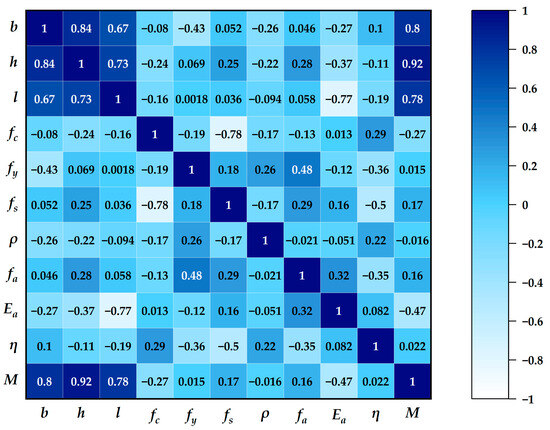
Figure 2.
Correlation analysis of input and output parameters.
4. Machine Learning Models
Machine learning automatically learns patterns or rules from data through algorithms and makes predictions for unknown data based on this. Ensemble learning, as an extension of machine learning, improves the predictive performance and robustness of the overall model by constructing and combining multiple base learners. Compared to a single machine learning algorithm, ensemble learning offers higher accuracy and generalization ability.
4.1. Bagging Ensemble Learning
Bagging through the random self-sampling of the initial training samples, multiple different sub-training sample sets are generated, and the base learners are independently trained on these subsets. Each base learner obtains the prediction results, and finally, the prediction results of all base learners were aggregated by voting or averaging in order to obtain a higher accuracy prediction [26].
Random Forest (RF)
RF was based on the Bagging concept, introducing random feature selection into the training process of decision trees. It randomly and with replacement selects samples from the original dataset and builds independent decision tree models for each subsample set. Each tree independently outputs results that were not correlated with one another. The final output [27] was generated by taking the mean of all tree outputs. The basic formula and algorithm construction principles and processes are shown in Formula (6) and Figure 3.
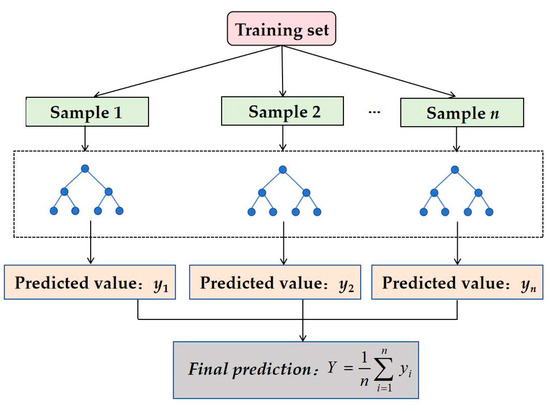
Figure 3.
Schematic diagram of regression prediction by RF.
The is the final prediction result, represents the regression prediction result of the i-th decision tree, and n represents the number of decision trees.
4.2. Boosting Ensemble Learning
Boosting integration learning is a machine learning method that constructs a strong learner by combining multiple weak learners. Its core idea was to train base models sequentially, with each subsequent model focusing on correcting errors from the previous one and gradually improving overall performance. The flowchart of the Boosting ensemble algorithm is shown in Figure 4. XGBoost, Adaboost, and LightGBM are common ensemble algorithms based on the Boosting principle.
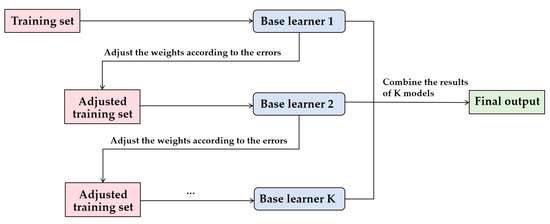
Figure 4.
Flowchart of the Boosting algorithm.
4.2.1. Xtreme Gradient Boosting (XGBoost)
XGBoost was an ensemble learning method first proposed by Chen [28] in 2014. It was an improvement and optimization of the traditional Gradient Boosting Decision Tree (GBDT). The traditional GBDT objective function only utilizes first-order derivative information, whereas XGBoost performs a second-order Taylor expansion on the objective function term, fully utilizing both first and second-order gradient statistics. This makes the process of finding the optimal solution more efficient. Additionally, XGBoost introduces a regularization term into the objective function to control model complexity and prevent overfitting. The objective function of the XGBoost algorithm was
The represents the objective function, n is the total sample size, is the measured value of the i-th target, is the predicted value of the i-th target, is the loss function, which measures the difference between the measured value and the predicted value in the model, is the regularization term of the model, representing the complexity of the model and preventing overfitting.
4.2.2. Adaptive Boosting (Adaboost)
The core principle of the integrated algorithm lies in iteratively training a series of weak learners. Each round of training dynamically adjusts sample weights based on classification errors from the previous round. Through this iterative process, samples that were misclassified were always considered in each training session, continuously reducing classification errors and enhancing the overall model performance [29]. The main steps include, first, initializing sample weights; then, iterating weak classifiers, calculating error rates in each round of training; next, computing the weight coefficients of weak classifiers and updating sample weights; finally, combining the results of weak classifiers with weighting to produce the final output. The calculation formula was
The represents the final strong classifier, K is the number of iterations, represents the prediction result of the weak classifier, and is the weight of the weak classifier.
4.2.3. Light Gradient Boosting Machine (LightGBM)
LightGBM was an iterative boosting tree system that improves upon Gradient Boosting Decision Trees (GBDTs). In the LightGBM algorithm, the gradient boosting decision tree was obtained through multiple iterations of the training dataset. Each iteration uses gradient information to refit a new tree, which is then added to the previous iteration’s tree. This process can be viewed as a continuously evolving linear combination process [30]. Compared to classical GBDT, LightGBM can simultaneously use the first and second-order negative gradients of the loss function to calculate the residual of the current tree and use this result to fit the next round of the new tree. The objective function of the LightGBM algorithm was
The represents the function space of the iterative tree, and represents the predicted value of the i-th sample on the k-th tree.
4.3. Hyperparameter Tuning
Hyperparameter optimization was a critical step in model training. To address the issue of overfitting and enhance model generalization ability, a random search strategy, and K-fold cross-validation method were applied to optimize the hyperparameters of the ML models, with the MAE as the optimization objective. Random search generates random combinations of hyperparameters within a predefined search space or range, applies these combinations to the model, trains the model using the training data, and finally identifies the hyperparameter set with the highest accuracy from all tested configurations. The training set was randomly divided into K non-overlapping subsets of equal sample size. In each fold, K-1 subsets were used for training, and the remaining subset was used for validation. The above steps were repeated K times to perform K validation processes. In this study, five-fold (K = 5) cross-validation was adopted, dividing the training set into five subsets.
During model development, the complete dataset was randomly partitioned into a training set and a test set, comprising 70% and 30% of the total samples, respectively. Hyperparameters for the four models were optimized and validated via random search and five-fold cross-validation. Table 3 presents the selected hyperparameters for the machine learning models.

Table 3.
Hyperparameters of aluminum-alloy-reinforced RC beam ML model.
5. Results and Discussions
The prediction values and linear correlation diagrams of all models on the training set and testing set are shown in Figure 5, Figure 6 and Figure 7, respectively. The figures indicated that all models can be used to predict the flexural bearing capacity of aluminum-alloy-reinforced RC beams. For both training and testing set samples, the predicted values of the XGBoost and LightGBM models were in good agreement with the experimental values, and they exhibited good correlation. Compared with RF, XGBoost, and LightGBM, the Adaboost model demonstrates a poorer performance.

Figure 5.
Performance of different models from training evaluation: (a) Evaluation of the RF model on the training set; (b) evaluation of the XGBoost model on the training set; (c) evaluation of the Adaboost model on the training set; (d) evaluation of the LightGBM model on the training set.
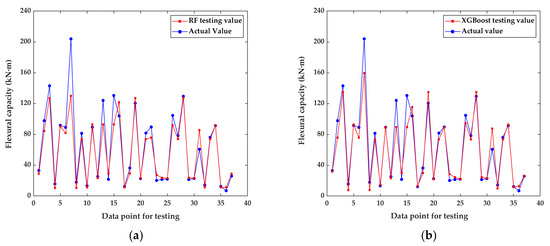

Figure 6.
Performance of different models from testing evaluation: (a) Evaluation of the RF model on the testing set; (b) evaluation of the XGBoost model on the testing set; (c) evaluation of the Adaboost model on the testing set; (d) evaluation of the LightGBM model on the testing set.
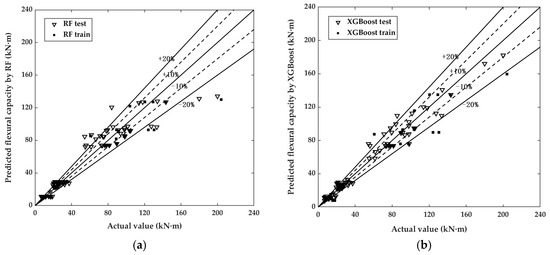

Figure 7.
Linear regression of training and testing performance: (a) Comparison of testing values and training values of the RF model; (b) comparison of testing values and training values of the XGBoost model; (c) comparison of testing values and training values of the Adaboost model; (d) comparison of testing values and training values of the LightGBM model.
Figure 7 shows the linear regression plots of the predicted values on the training set and testing set to reflect the fitting performance. Most of the predicted values were distributed within the error percentage range of ±20%, indicating that the ML model for the flexural bearing capacity of aluminum-alloy-reinforced RC beams was reliable when comprehensively considering 10 input variables. Compared with the other three models, the LightGBM model exhibited better fitting performance, with only a few data points falling outside the ±20% range. In contrast, the Adaboost model had the largest number of predicted values outside this range, indicating the worst-fitting performance.
The evaluation indicators for quantifying the flexural bearing capacity prediction of the models were listed in Table 4, including R2, RMSE, and MAE for both the training set and the testing set. For the RF, XGBoost, Adaboost, and LightGBM models, the percentage errors of R2 values in the training set and testing set were 2.22%, 5.28%, 8.68%, and 4.02%, respectively. Obviously, the R2 of the testing set of all models did not decrease significantly. The magnitude of MAE changes was greater than that of R2, which may be due to the fact that the dataset contains many strongly correlated characteristics, such as the strength and elastic modulus of aluminum alloy, etc., which may cause the model to capture excessively collinear noise. As can be seen from the data in Table 3, both the XGBoost and LightGBM models exhibited high R2 values (R2 > 0.9) in both the training and test sets. Notably, LightGBM demonstrated smaller values in other evaluation metrics (RMSE and MAE), underscoring its superior accuracy on the testing set. The Adaboost model recorded an R2 of 0.910 in the training set and 0.831 in the testing set, indicating that while it can predict the functional relationships within the existing database, its generalization capability was inferior to that of the other three models. The LightGBM model attained R2 values of 0.971 and 0.932 for the training set and test set, respectively, with both RMSE and MAE metrics surpassing the other models: the R2 values on the training set were 7.65%, 0.52%, and 6.70% higher than those of the RF, XGBoost, and Adaboost models, respectively; the corresponding improvements on the testing set were 5.67%, 1.86%, and 12.15%. Meanwhile, the RMSE values on the training set were reduced by 43.60%, 2.18%, and 42.61% compared to the other models, respectively; the reductions on the testing set were 27.25%, 7.70%, and 36.90%, respectively. The MAE values on the training set were reduced by 49.71%, 5.85%, and 46.54% relative to the other three models, respectively; the corresponding reductions on the test set were 32.75%, 4.63%, and 44.06%, respectively. Comprehensive analysis indicates that the LightGBM model outperforms the other three models, followed by XGBoost. When considering computational efficiency and model complexity, the LightGBM model can be preferentially used to predict the flexural bearing capacity of beams.

Table 4.
Evaluation indicators of different prediction models.
Figure 8 shows the distribution of absolute errors. The median errors of the RF, XGBoost, and LightGBM models remained relatively low, whereas AdaBoost exhibited the highest median value. The absolute error data points of both RF and LightGBM models were comparatively concentrated, though RF contained more outliers. Notably, AdaBoost presented the longest box, signifying a more dispersed error distribution and relatively inferior stability.
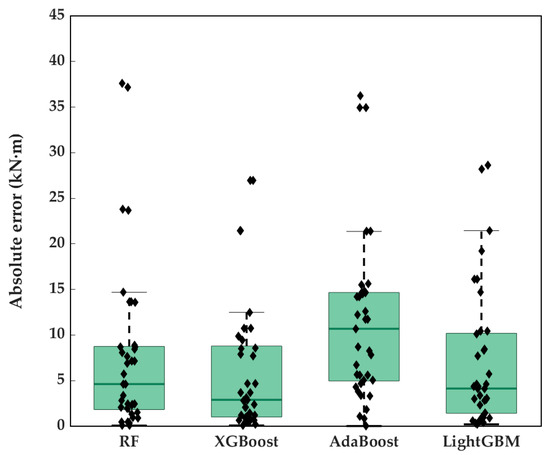
Figure 8.
Boxplot of absolute errors.
Figure 9 represents a Taylor diagram, which visualizes the statistical relationship between model-predicted values and experimental values through polar coordinates. It was used to compare the correlation coefficients, standard deviations, and RMSE of different ML models, providing multi-dimensional indicators to evaluate model performance. As shown in the figure, all the ML models exhibited high correlation coefficients and low RMSE values. Among them, the LightGBM model demonstrated the best prediction accuracy, with the highest correlation coefficient, the smallest RMSE value, and the shortest distance to the observation points.
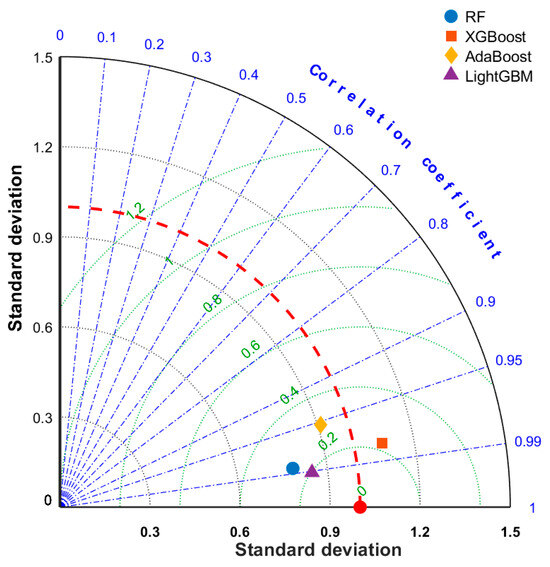
Figure 9.
Taylor diagram presents the evaluation of machine learning models.
Based on the comprehensive analysis of the above charts, the LightGBM model performs optimally among the four models in this study, making it suitable for predicting the flexural bearing capacity of RC beams with rectangular sections strengthened by aluminum alloy. The interpretability analysis of this model is conducted as follows.
The SHAP algorithm was applied to determine the significance of factors influencing the flexural behavior. SHAP values for each input parameter were computed using the optimized LightGBM model, enabling quantification of their marginal contributions to the predicted flexural capacity. Figure 10 presents the feature importance scores derived from SHAP values, which reflect the aggregate influence of each parameter on the model’s predictive outcomes. Figure 10b presents the SHAP distribution of each feature variable, depicting the contribution magnitude and directional impact of individual features across specific samples. Here, red signified high feature values, while blue indicated low feature values. As can be observed from the figure, both h and b exhibited significant impacts on the output results, whereas the influence of η was relatively minor, and other parameters showed negligible effects. On average, h was the most important parameter that affected the bearing capacity. Notably, the aluminum alloy strengthening parameters were not the decisive factors for the flexural bearing capacity of RC beams. This phenomenon aligned with engineering intuition, as the role of aluminum alloy strengthening was merely to further enhance the bearing capacity on the basis of the beam’s original capacity, while the decisive factors still lie in the inherent properties of the beam itself.
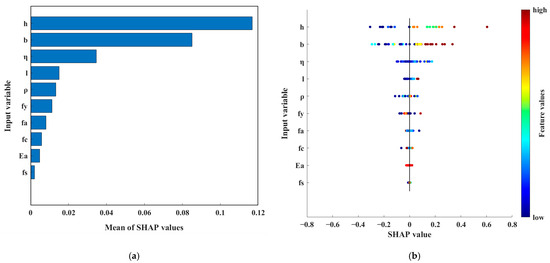
Figure 10.
Analysis of the importance of machine learning model: (a) Display the importance ranking of each input variable; (b) the SHAP values of each input variable.
The Partial Dependence Plot (PDP) serves as a powerful visualization tool to elucidate the manner in which variations in specific features impact the model’s predictive outcomes under the condition that all other features are held constant. Figure 11 demonstrates the relationship between the top three important characteristic variables and Shapley values. From the figure, it is evident that the SHAP value demonstrates a gradual increase with the increment of h. When h > 360 mm, the SHAP value exhibits a rapid escalation, signifying a highly significant impact on the bearing capacity. Additionally, when b > 170 mm, it exerts a positive influence on the model’s predicted values, accompanied by a gradual increase in the SHAP value. When η is within the range of 3.15–3.39%, increasing the amount of aluminum alloy reinforcement significantly enhances the bearing capacity. However, as η increases beyond this range, the SHAP value gradually decreases, indicating that a higher dosage of aluminum alloy does not necessarily lead to better improvements in the beam’s bearing capacity. Excessive usage may even yield negative effects, which is consistent with the experimental results.
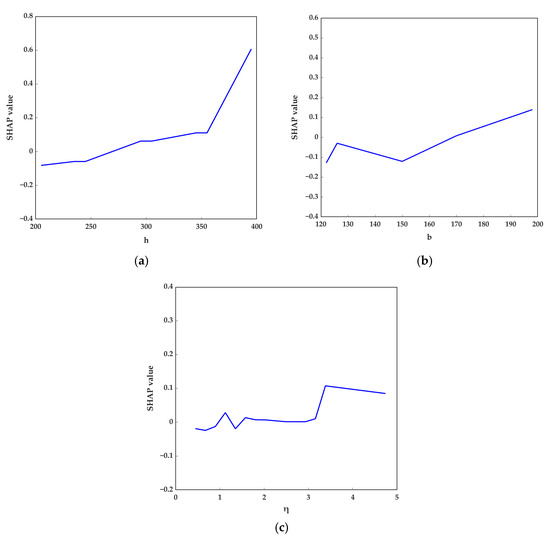
Figure 11.
Relationship between the characteristic variables and the SHAP values: (a) Presenting the influence law of feature h on the bearing capacity; (b) presenting the influence law of feature b on the bearing capacity; (c) presenting the influence law of feature b on the bearing capacity.
6. Conclusions
In this study, four ML models were developed using experimental data to predict the flexural bearing capacity of aluminum-alloy-strengthened RC beams. The K-fold cross-validation method was employed for hyperparameter tuning to ensure the generalization ability and effectiveness of the models. Additionally, SHAP was utilized for interpretability analysis. The results showed that the ML models perform exceptionally well in predicting the flexural bearing capacity. The following conclusions were drawn from this study:
- (1)
- The R2 values of the four models on the training and test sets exceeded 90% and 83%, respectively, indicating that machine learning is applicable for predicting the flexural capacity of rectangular RC beams strengthened with different aluminum alloy methods.
- (2)
- LightGBM model exhibited the optimal performance with an R2 = 0.932, RMSE = 12.066 kN, and MAE = 7.897 kN among the ML models developed in this study.
- (3)
- The SHAP algorithm was employed to analyze the feature correlations in the predictive outcomes of the ML models. The results indicate that the beam height (h) is the most influential feature among all input parameters.
- (4)
- Based on the feature dependency analysis, designers can adjust the relevant characteristics for RC beam strengthening according to the research results of this paper and in combination with practical conditions.
- (5)
- Given the limited scale of the dataset in this study, it may have a certain impact on model accuracy. Future research intends to expand the dataset through multiple channels: on the one hand, continuously collecting experimental data from relevant literature; on the other hand, employing cutting-edge technologies such as data augmentation, synthetic data generation, and transfer learning to expand the data volume, thereby further improving the model’s prediction accuracy. Meanwhile, the model’s prediction results will be systematically compared and validated against existing theoretical specification formulas to ensure their reliability and effectiveness. Additionally, future research will conduct a targeted series of experiments to collect experimental data samples covering various cross-sectional forms beyond rectangular ones so as to comprehensively validate and optimize the generalization ability and scalability of the machine learning model and promote the in-depth development of research in this field.
Author Contributions
Methodology, C.M., J.H. (Jun Huang) and T.L.; Formal analysis, C.M.; Software, C.M., J.H. (Junzhong Huang) and Y.Y.; Resources, J.H. (Junzhong Huang); Writing—original draft, C.M.; Writing—review and editing, J.H. (Jun Huang). All authors have read and agreed to the published version of the manuscript.
Funding
The Funding was provided by Middle-aged and Young Teachers’ Basic Ability Promotion Project of Guangxi [Grant no. 2024KY1893; 2021KY1810; 2025KY1203].
Data Availability Statement
Data are contained within the article.
Conflicts of Interest
Author Junzhong Huang was employed by the company Guangxi Construction Engineering Group No.4 Construction Engineering Co., Ltd. The remaining authors declare that the research was conducted in the absence of any commercial or financial relationships that could be construed as a potential conflict of interest.
References
- Abuodeh, O.R.; Hawileh, R.A.; Abdalla, J.A. Nonlinear finite element models of reinforced concrete beams strengthened in bending with mechanically fastened aluminum alloy plates. Comput. Struct. 2021, 253, 106573. [Google Scholar] [CrossRef]
- Abdalla, J.A.; Hawileh, R.A.; Rasheed, H.A. Behavior of reinforced concrete beams strengthened in flexure using externally bonded aluminum alloy plates. Procedia Struct. Integr. 2022, 37, 652–659. [Google Scholar] [CrossRef]
- Zhang, Z.; Liu, Y.; Li, L. The use of bolted side aluminum alloy plates for flexural capacity of reinforced concrete beams: An experimental investigation. Structures 2022, 42, 417–433. [Google Scholar] [CrossRef]
- Yang, L.J.; Deng, Z.H.; Yang, H.F. Flexural Testing of Reinforced Concrete Beams Retrofitted Using Aluminum Alloy Plates. Space Struct. 2021, 27, 73–81. [Google Scholar]
- Xing, G.H.; Huang, J.; Luo, X.B.; Chang, Z.Q. Analysis and calculation of cracks in reinforced concrete beams with embedded prestressed aluminum alloy bars. Eng. Mech. 2022, 39, 171–181. [Google Scholar]
- Abuodeh, O.R.; Abdalla, J.A.; Hawileh, R.A. The flexural behavior of bolting and bonding Aluminum Alloy plates to RC beams. Procedia Struct. Integr. 2019, 17, 395–402. [Google Scholar] [CrossRef]
- Rasheed, H.A.; Abdalla, J.; Hawileh, R.; Al-Tamimi, A.K. Flexural behavior of reinforced concrete beams strengthened with externally bonded Aluminum Alloy plates. Eng. Struct. 2017, 147, 473–485. [Google Scholar] [CrossRef]
- Chang, H. Experimental Study on Strengthening UPC Beam with Inorganic Adhesive Aluminum Alloy Plate. Master’s Thesis, Harbin Institute of Technology, Harbin, China, 2018. [Google Scholar]
- Huang, H.L.; He, P.G.; Zhou, F.L.; Tan, Y.J. Flexural performance test and normal section bearing capacity of RC beams reinforced with aluminum alloy plates. Highw. Traffic Technol. 2024, 41, 105–115+125. [Google Scholar]
- Xing, G.H.; Chen, X.; Huang, J.; Zhang, Y. Reinforced concrete beams strengthened in flexure with near-surface mounted 7075 aluminum alloy bars. J. Struct. Eng. 2022, 148, 04021242. [Google Scholar] [CrossRef]
- Wu, H.; Xu, F.Q.; Xie, J. Influence of different reinforcement methods of aluminum alloy plates on flexural performance of RC beams. Seism. Eng. Reinf. Reconstr. 2023, 45, 115–122. [Google Scholar]
- Machello, C.; Baghaei, K.A.; Bazli, M. Tree-based machine learning approach to modelling tensile strength retention of Fibre Reinforced Polymer composites exposed to elevated temperatures. Compos. Part B Eng. 2024, 270, 111132. [Google Scholar] [CrossRef]
- Bhardwaj, H.K.; Shukla, M. Machine Learning-Based Improved Creep Life Prediction of 316 Austenitic Stainless Steel with Add-on Chemical and Microstructural Features. J. Mater. Eng. Perform. 2025, 1–19. [Google Scholar] [CrossRef]
- TQ, A.D.; Masoodi, A.R.; Gandomi, A.H. Unveiling the potential of an evolutionary approach for accurate compressive strength prediction of engineered cementitious composites. Case Stud. Constr. Mater. 2023, 19, e02172. [Google Scholar]
- Khademi, P.; Mousavi, M.; Dackermann, U. Enhancing load prediction for structures with concrete overlay using transfer learning of time–frequency feature-based deep models. Eng. Struct. 2024, 305, 117734. [Google Scholar] [CrossRef]
- Le, Q.H.; Nguyen, D.H.; Sang-To, T. Machine learning based models for predicting compressive strength of geopolymer concrete. Front. Struct. Civ. Eng. 2024, 18, 1028–1049. [Google Scholar] [CrossRef]
- Ghodratnama, M.; Masoodi, A.R.; Gandomi, A.H. AI-driven modeling for predicting compressive strength of recycled aggregate concrete under thermal conditions for sustainable construction. Clean. Eng. Technol. 2025, 26, 100959. [Google Scholar] [CrossRef]
- Eilbeigi, S.; Tavakkolizadeh, M.; Masoodi, A.R. Nonlinear Regression Prediction of Mechanical Properties for SMA-Confined Concrete Cylindrical Specimens. Buildings 2023, 13, 112. [Google Scholar] [CrossRef]
- Chen, X.Z.; Jia, J.F.; Bai, Y.L. Prediction model of axial bearing capacity of concrete-filled steel tube column based on XGBoost-SHAP. J. Zhejiang Univ. 2023, 57, 1061–1070. [Google Scholar]
- Manan, A.; Zhang, P.; Ahmad, S. Prediction of flexural strength in FRP bar reinforced concrete beams through a machine learning approach. Anti-Corros. Methods Mater. 2024, 71, 562–579. [Google Scholar] [CrossRef]
- Zhang, S.Y.; Chen, S.Z.; Han, W.S.; Wu, G. Prediction of flexural capacity of concrete beams reinforced by FRP based on ensemble learning. Eng. Mech. 2022, 39, 245–256. [Google Scholar]
- Ran, L.; Wu, W.; Zhou, L. Evaluation of Axial Compressive Bearing Capacity of Glass Fiber Reinforced Polymer (GFRP) Bar-Reinforced Concrete Columns. Compos. Sci. Eng. 2024, 10, 72–78. [Google Scholar]
- Ahmed, A.; Uddin, M.N.; Akbar, M. Prediction of shear behavior of glass FRP bars-reinforced ultra-highperformance concrete I-shaped beams using machine learning. Int. J. Mech. Mater. Des. 2024, 20, 269–290. [Google Scholar] [CrossRef]
- Lundberg, S.M.; Lee, S.I. A unified approach to interpreting model predictions. arXiv 2017, arXiv:1705.07874. [Google Scholar]
- Tu, G.G. Experimental Research and Numerical Analysis of Reinforced Concrete Beams Reinforced by Aluminum Alloy. Master’s Thesis, Harbin Institute of Technology, Harbin, China, 2011. [Google Scholar]
- Breiman, L. Bagging predictors. Mach. Learn. 1996, 24, 123–140. [Google Scholar] [CrossRef]
- Fawagreh, K.; Gabe, M.M.; Elyan, E. Random forests: From early developments to recent advancements. Syst. Sci. Control Eng. 2014, 2, 602–609. [Google Scholar] [CrossRef]
- Chen, T.; Guestrin, C. Xgboost: A scalable tree boosting system. In Proceedings of the 22nd ACM Sigkdd International Conference on Knowledge Discovery and Data Mining, San Francisco, CA, USA, 13–17 August 2016. [Google Scholar]
- Freund, Y.; Schapire, R.E. A decision-theoretic generalization of on-line learning and an application to boosting. J. Comput. Syst. Sci. 1997, 55, 119–139. [Google Scholar] [CrossRef]
- Ke, G.; Meng, Q.; Finley, T. Lightgbm: A highly efficient gradient boosting decision tree. Adv. Neural Inf. Process. Syst. 2017, 30, 3146–3154. [Google Scholar]
Disclaimer/Publisher’s Note: The statements, opinions and data contained in all publications are solely those of the individual author(s) and contributor(s) and not of MDPI and/or the editor(s). MDPI and/or the editor(s) disclaim responsibility for any injury to people or property resulting from any ideas, methods, instructions or products referred to in the content. |
© 2025 by the authors. Licensee MDPI, Basel, Switzerland. This article is an open access article distributed under the terms and conditions of the Creative Commons Attribution (CC BY) license (https://creativecommons.org/licenses/by/4.0/).